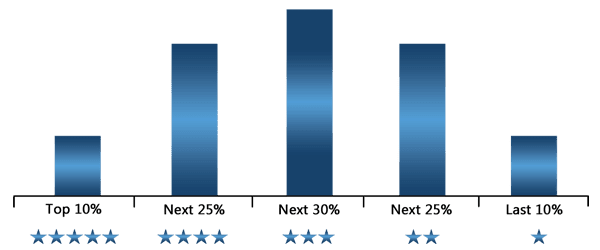Equity Funds Rating Methodology:
Data mining is extraction of hidden predictive information from large databases. We at RupeeVest, have used extensive data mining tools to unearth a wide range of factors like historical returns, consistency of return, benchmark outperformance, volatility, etc. which have historically (over 20 years of data) proven to have a significant influence over the future performance of a fund.
RupeeVest proprietary algorithms have been developed after a long process of research which combine these data mining tools with advanced mathematics to spot funds with the highest probability of outperformance.
While not guaranteed, the top rated funds as a group are expected to do better than the category average and benchmark index of the respective fund over a 12 month horizon. Although, the ratings are revised every quarter but, the funds which receive top rating at the end of each quarter is valid for them for the following 12 months. For ELSS funds, the top rated funds performance is measured over the next 36 months as investors are locked in for that period.
The primary objective of RupeeVest Equity Funds Rating Methodology is to provide holistic insight into how a mutual fund is currently positioned for the subsequent 12 months (36 months for ELSS funds), rather than assuming that a fund with a superior track record in the near past would continue to do so in the foreseeable future. However, the fund ratings should be used as a starting point for fund selection and should not be the sole basis for making investment decisions.
Debt Funds Rating Methodology:
We look into these funds 1 year and 3 year performance as proven track record is an important criteria while evaluating the consistency and stability of a fund. To assess the risk aspect, each fund's portfolio holding is assigned a credit score based on the credit rating received by recognised rating agencies. Then, each fund's weighted average portfolio credit score is computed and compared to other funds within the category.
Thus, a combination of high portfolio credit score along with top tier returns is essential for a fund to receive top rating.
Hybrid Funds Rating Methodology:
We primarily look into these funds 1 year, 2 year and 3 year performance as proven track record is an important criteria for evaluating hybrid funds. For debt oriented hybrid funds, portfolio credit score is also given due weightage to assess portfolio credit risk.
Classification of stocks by Market Capitalisation
The stocks are classified as Large, Mid and Small Cap as per the last 6 months average market capitalization and allocated as below:
Large Caps = Top 100 stocks
Mid Caps = Next 150 stocks
Small Caps = Rest of the stocks
This method of classification is not affected by the overall market movement as the stocks are classified relative to each other. However, as individual stocks rise or decline more than the rest of the market, they may move from one category to another over a period of time. Using this classification, the equity funds are allocated to categories which best reflect their characteristics which is essential for comparison and rating.





